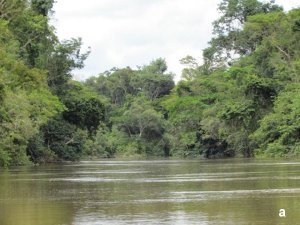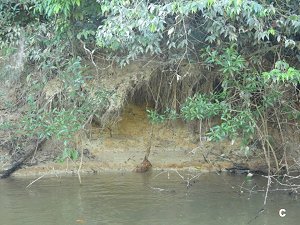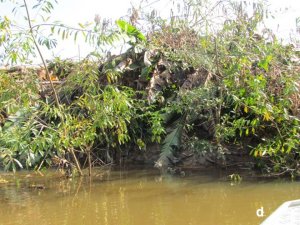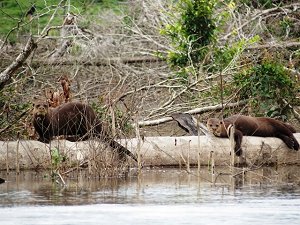IUCN/SSC Otter Specialist Group Bulletin

|
©IUCN/SCC Otter Specialist Group Volume 32 Issue 1 (January 2015) Citation: Calaça, AM, Faedo, OJ and de Melo, FR (2015). Hydroelectric Dams: The First Responses from Giant Otters to a Changing Environment. IUCN Otter Spec. Group Bull. 32 (1): 48 - 58 Hydroelectric Dams: The First Responses from Giant Otters to a Changing Environment Analice Maria Calaça1, Odair José Faedo2, and Fabiano Rodrigues De Melo3
1Universidade Federal do Rio de Janeiro, Instituto de Biologia, Programa de Pós-Graduação em Ecologia, Ilha do Fundão, 21941-590. Rio de Janeiro, RJ, Brazil. e-mail: analicecalaca@gmail.com (*corresponding author) |



|
| Abstract: The construction of hydroelectric dams has been cited as one of the threats faced by giant otter populations in their distribution areas. However, studies evaluating the impact of reservoirs on these populations are scarce and often restricted to results about the post-filling period. In this study, we present distribution and behavioral data from giant otter populations living in the Teles Pires River and tributaries, located in the municipality of Paranaíta in the State of Mato Grosso, Brazil, during the pre-filling period. The species showed a homogeneous distribution throughout the sample site during the initial monitoring phase; this distribution changed to sparse after the beginning of the work to remove the riparian vegetation, possibly because of intense noise and movement of people. However, otters returned during other campaigns, rebuilding destroyed dens and building new ones in recently exposed bounds, indicating a possible adaptation to the first environmental filter promoted by the project: the structural change of the environment. Two other subsequent important filters challenging the species survival are related to the loss of habitat with the rise of water levels and changes in the composition and abundance of food resources. These factors are being monitored since the filling of the Teles Pires reservoir, beginning in December of 2014, for future comparisons between the two periods. |
| Keywords: habitat use, deforestation, hydroelectric dams, environmental filter, Pteronura brasiliensis. |
| Française | Español |
INTRODUCTION
The construction of hydroelectric dams has been considered a threat to semiaquatic mammal populations due to significant alterations to the environment that has transformed from lotic to lentic (Carter and Rosas, 1997; Leuchtenberger et al., 2013). The main factors that must be taken into account in predicting environmental impact include changes in the distribution and composition of resources and the presence of humans, which are obvious characteristics of these environments (Carter and Rosas, 1997; Rosas et al., 2007; Oliveira et al., 2015).
Because giant otter (Pteronura brasiliensis) populations depend on both the aquatic environment to obtain resources, predominantly fish, and the terrestrial environment to build dens to rest and rear their offspring, they are strongly affected by the dynamics of these ecosystems, especially in terms of seasonality (Utreras et al., 2005; Leutchenberger et al., 2015). Dam projects can also affect such dynamics because the filling of reservoirs influences the availability, distribution, and quality of resources in the water and causes the loss of terrestrial habitats (Carter and Rosas, 1997; Palmeirim et al., 2014).
Studies about the ability of giant otter populations to use habitats changed by hydroelectric projects are still in their infancy. The most significant studies, conducted in the Balbina Lake dam reservoir in the Amazon since 2001, reveal a large number of individuals using the reservoir, which suggests some level of adaptability to changes (Rosas et al., 2007; Cabral et al., 2010). However, these populations have not been monitored prior to the reservoir construction (comparisons between populations are based on data from rivers and creeks adjacent to the lake) and the reported data correspond to the post-filling period only, which does not allow accurate comparisons between pre- and post-filling periods and identification of possible population trends.
Here we present information on the distribution and behavioral aspects of giant otter populations during the reservoir pre-filling period at the Teles Pires hydroelectric power plant (UHE), located in the municipality of Paranaíta, in Mato Grosso, Brazil, particularly after a major change in the environment due to deforestation of river banks for reservoir filling
MATERIAL AND METHODS
The Teles Pires hydroelectric dam is one among at least five planned dams to be built on the Teles Pires River, one of the major tributaries of the Juruena River. It has a capacity of 1,820 MW of Power and a lake with an area of 152 km2 will form. The plant is part of the municipality of Paranaíta, located 60 km from Alta Floresta, in the extreme north of Mato Grosso State. The region is rich in mammals, with at least 37 species of reported medium and large size mammals (Michalski and Peres, 2007). Giant otters particularly have been studied in the region since 2007 (Norris and Michalski, 2009).
The monitoring of giant otters was conducted from June 2012 to September 2014 through ten quarterly campaigns with duration of 10 days each on a stretch of 119 km along the Teles Pires River and its tributaries. Four main sampling areas were delimited including one area located on the Paranaíta River (Area 3; 34 km), the most affected by reservoir filling (Fig. 1).
 |
| Figure 1. Location of the study area, Northern Mato Grosso State, Brazil. Red dots represent records of giant otters in the sampling area. (click for larger version) |
The monitored stretches are characterized by a high environmental heterogeneity containing dense areas of primary and secondary forests at different stages of succession and with different levels of anthropic intervention. The Paranaíta River is particularly characterized by stones and degraded and exposed banks. The area contains secondary riparian forests that, in some stretches, are significantly accessed by watering cattle. Although the human density is low along this river, some points in the whole stretch are heavily visited by fishermen.
A boat (6 meters long) with a 25 HP engine at a speed of approximately 7 km/h was used to sample and study the distribution of giant otter groups. Both riverbanks were inspected in the search for direct and indirect evidence of the presence of giant otters. When evidence was detected, the site was georeferenced, and its characteristics were recorded and examined. Different groups were identified based on their unique throat markings, allowing a minimum estimate of the studied population (Groenendijk et al., 2005; Leuchtenberger et al., 2012.). However, we did not capture for implanting intraperitoneal radio-transmitters, which is a more robust and efficient method to evaluate the composition and home range of groups (Siveira et al., 2011; Leuchtenberger et al., 2015).
RESULTS
A total of 5443 km along the Teles Pires and Paranaíta Rivers was covered throughout ten seasonal campaigns in the search for direct and indirect evidence of giant otter populations. A total of 230 independent observations were recorded including sightings (n=34), footprints (n=63), resting areas (n=49), faeces (n=41), dens (n=25), and campsites (n=16). Through these records, it was possible to identify 18 individuals belonging to eight family groups; however only two groups inhabited the Paranaíta River (Area 3).
The clearing of a large portion of the Paranaíta River margin for the construction of a hydroelectric reservoir (Fig. 2a and 2b) destroyed six previously monitored dens (Fig. 2c and 2d) during the seventh campaign (flooding season), held in December of 2013. Only two old indirect signs of giant otters were recorded during this period. Because of the noise from machines and intense movement of people, we assumed that the otters might have moved to the Teles Pires River or other small tributaries.
A group of three individuals were observed resting on fallen tree trunks in the eighth campaign (rainy season), held in March of 2014 (Fig. 3). This observation indicated a possible return of otters to the site. Generally, the number of records drops considerably during this seasonal period because of the expansion of the species' home range into the creeks and the rising of water levels covering dens and banks (Duplaix, 1980).
The ninth campaign, performed in June of 2014, was characterized by receding waters. All dens that had been destroyed or obstructed were rebuilt in the same location, indicating fidelity to the den sites, and the increase in dry areas, exposing extended bound areas, allowed the construction of several new dens along the river as well as active resting places and campsites (Fig. 4). In the subsequent campaign, the last one before the filling of the reservoir, these dens were still active.
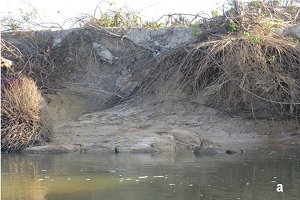  |
| Figure 4. Resting area (a) and dens (b) built on cleared banks of the Paranaíta River, Mato Grosso.. (click for larger version) |
DISCUSSION
Fragmentation and habitat loss are certainly the main direct and immediate impacts of the implementation of hydroelectric dams on species and can be considered an important environmental filter in the communities (Davies et al., 2000; Canale et al., 2013). Environmental filters are characterized as any type of weather conditions, disturbance regimes, and biotic interactions that may influence the distribution of species through their functional attributes (Keddy, 1992). Thus, species with attributes unsuitable to surviving certain environmental conditions are the first to be eliminated (Keddy, 1992; Henle et al., 2004).
The return of giant otters to a disturbed and completely mischaracterized environment, as evidenced by the construction and reconstruction of dens, resting places, and campsites for shelter, reproduction, and daily activities that include social interactions (Leuchtenberger and Mourão, 2008; Lima et al., 2012; Leuchtenberger et al., 2013), demonstrates that the species overcame the first environmental filter created by the structural habitat alteration. This was probably the result of the species' dispersion capabilities and suggests that the returning otters are trying to adapt to the new conditions where riverbanks are totally devoid of forest.
The next environmental filter created by the construction of hydroelectric dams after deforestation and the consequent structural alteration of the riparian environment will be the flooding of the habitat. Rising water levels will cause a considerable decrease in the number of banks and other structures, resulting in habitat loss. However, at the Balbina hydroelectric plant, an expansion of the area of distribution of giant otters was observed after the formation of the reservoir. The species incorporated various elements of the landscape, including new channels and islands formed, within their home range (Rosas et al., 2007). In addition to habitat loss, changes in water chemistry can affect the composition and abundance of fish and other food resources for the giant otter (Zuanon et al., 2002; Rosas et al., 2007). This will certainly be another filter imposed by the changing environment in the post-filling period.
The ability of this species to overcome environmental filters imposed by the environment will dictate whether they can survive and adapt to the deep and abrupt changes observed with the construction of reservoirs. These changes are often considered as one of the main factors for the decline of giant otter populations (Duplaix et al., 2008). We observed that the giant otter has managed to overcome the first of at least three environmental filters in the studied area, which results from the construction of hydroelectric dams: fragmentation, and consequent habitat alteration. Other long-term studies report that giant otters were able to overcome two types of filters. They were not affected by habitat loss caused by flooding, and maintained their diet composition by increasing their living range to adjacent undisturbed areas (Zuanon et al., 2002; Rosas et al., 2007; Cabral et al., 2010). Nevertheless, Palmeirim et al. (2014) recently demonstrated that, even with the possibility of living area expansion necessitated by flooding, giant otter populations diminished because of reduced habitat quality in the Balbina reservoir.
Thus, even if otters are returning to the degraded areas, there is no guarantee that they can survive the sub-optimal conditions offered by the environment currentlhy being formed. The length of time that these groups will remain in these environments after its complete modification is unknown and must to be studied in the future. In addition, regions with strong forest fragmentation such as the studied region (Michalski and Peres 2005, 2007; Norris and Michalski, 2009) can present low occupancy capacity for groups of otters, which reinforces the concern with the permanence of these observed groups after the complete filling of the lake and the side effects from this process.
The beginning of the filling of the Teles Pires reservoir occurred in December of 2014, from which it has been possible to evaluate and monitor the influence of other environmental filters on the species. Hence, more years of monitoring these groups are necessary to evaluate the relevant effects promoted by habitat alterations and the level of impact that will result on these already threaten animals.
Acknowledgements - We are thankful for the Teles Pires Hydroelectric Company and the Biota Projects and Environmental Consulting LTDA. for their overall and logistical support in the field. We are also thankful to Diego Silva, Douglas Lara, Uécson Suendel, Rafael Grisostenes, and the field technicians, Edson Dias and Roque Prates, for their important assistance in data collection. Many thanks to Romari Martinez to help us with the abstract in Spanish and Alexandre Vale for creating the sample area map.
REFERENCES
Cabral, M.M.M., Zuanón, J.,
de Mattos, G.E., Rosas, F.C.W. (2010). Feeding habits of giant
otters Pteronura brasiliensis (Carnivora: Mustelidae) in the
Balbina hydroelectric reservoir, Central Brazilian Amazon. Zoologia,
27: 47-53.
Canale, G.R., Peres, C.A., Guidorizzi, C.E., Gatto, C.A.F., Kierulff,
C.M. (2013). Pervasive defaunation of Forest remnants in a Tropical
biodiversity hotspot. PLOS, 7: e41671.
Carter, S.K., Rosas, F.C.W. (1997). Biology and conservation of the
giant otter Pteronura brasiliensis. Mammal Rev.
27: 1-26.
Davies, K.F., Margules, C.R., Lawrence, J.F. (2000). Which traits of
species predict population declines in experimental forest fragments?
Ecology, 81: 1450-1461.
Duplaix, N. (1980). Observations on the ecology and behavior of the
giant river otter, Pteronura brasiliensis, in Suriname. Rev. Ecol.
(Terre Vie), 34: 496-617.
Duplaix, N., Waldemarin, H.F., Groenedijk, J., Evangelista, E., Munis,
M., Valesco, M., Botello, J.C. (2008). Pteronura brasiliensis.
In: IUCN
2014. IUCN Red List of Threatened Species. Version 2014.2. URL:
www.iucnredlist.org. Downloaded
on 25/08/2014.
Groenendijk, J., Hajek, F., Duplaix, N. Reuther, C., Van Damme, P., Schenck, C., Staib, E., Wallace, R., Waldemarin, H., Notin, R., Marmontel, M., Rosas, F., de Mattos, G.E., Evangelista, E., Utreras, V., Lasso, G., Jacques, H., Matos, K., Roopsind, I., Botello, J.C. (2005). Surveying and Monitoring Distribution and Population trends of the Giant Otter (Pteronura brasiliensis) – Guidelines for a Standardisation of Survey Methods as Recommended by the Giant Otter Section of the IUCN/SSC Otter Specialist Group. Habitat 16: Arbeitsberichte der Aktion Fischotterschutz e.V., ISBN 3-927650-26-9, 100pp.
Henle, K., Davies, K.F., Kleyer, M., Margules, C., Settele, J. (2004).
Predictors of species sensitivity to fragmentation. Biodivers. Conserv.
13: 207–251.
Keddy, P.A. (1992). Assembly and response rules: two goals for
predictive community ecology. J. Veg. Sci. 3: 157-164.
Leuchtenberger, C., Mourão, G. (2008). Social Organization and
Territoriality of Giant Otters (Carnivora: Mustelidae) in a Seasonally
Flooded Savanna in Brazil. Sociobiology, 52: 257-270.
Leuchtenberger, C., Ribas, C., Magnusson, W., & Mourão, G. (2012). To each his own taste: latrines of the giant otter as a food resource for vertebrates in Southern Pantanal, Brazil. Studies on Neotropical Fauna & Environment, 47(2), 81-85
Leuchtenberger, C., Magnusson, W. E., Mourão, G. (2015). Territoriality
of giant otter groups in a area with seasonal flooding. PLOS,
10 (5): 1-
13.
Leuchtenberger, C., Oliveira-Santos, L.G.R., Magnusson, W., Mourão, G.
(2013). Space use by giant otter groups in the Brazilian Pantanal.
J.
Mammal. 94: 320-330.
Lima, D.S., Marmontel, M., Bernard, E. (2012).
Site and refuge use by
giant river otters (Pteronura brasiliensis) in the western Brasilian
Amazonia. J. Nat. Hist. 46: 729-739.
Michalski, F., Peres, C.A. (2005). Anthropogenic determinants of primate
and carnivore local extinctions in a fragmented forest landscape of
southern Amazonia. Biol. Conserv. 124: 383-396.
Michalski, F., Peres, C.A. (2007). Disturbance-mediated mammal
persistence and abundance-area relationships in Amazonian forest
fragments. Conserv. Biol. 6:1626-1640.
Norris, D., Michalski, F. (2009).
Are otters an effective flagship for
the conservation of riparian corridors in an Amazon deforestation
frontier? IUCN Otter Spec. Group Bull.26: 73-77.
Oliveira, IA, Norris, D and Michalski, F (2015). Anthropogenic and seasonal determinants of giant otter sightings along waterways in the northern Brazilian Amazon. Mammalian Biology - Zeitschrift für Säugetierkunde, 80: 39-46
Palmeirim, A.F., Peres, C.A., Rosas, F.C.W. (2014). Giant otter
population responses to habitat expansion and degradation induced by a
mega hydroelectric dam. Biol. Conserv. 174: 30-38.
Rosas, F.C.W., de Mattos, G.E., Cabral, M.M.M. (2007). The use of
hydroelectric lakes by giant otters Pteronura brasiliensis: Balbina Lake
in central Amazonia, Brazil. Oryx, 41 (4): 520-524.
Silveira, L., Furtado, M.M., Rosas, F.C.W., Silva, L.C.L.C., Cabral,
M.M.M., Tôrres, N.M., Sollmann, R., Kouba, A., Jácomo, A.T.A. (2011).
Tagging giant otters (Pteronura brasiliensis) (Carnivora, Mustelidae)
for radio-telemetry studies. Aquatic Mammals, 37 (2): 208-212.
Utreras, V.B., Suarez, E.R., Zapata-Ríos, G., Lasso, G., Pinos, L.
(2005). Dry and rainy season estimations of giant otter, Pteronura
brasiliensis, home range in the Yasuní National Park, Ecuador. LAJAM, 4:
191-194.
Zuanon, J.A.S., Mattos, G.E., Rosas, F.C.W. (2002). Hábitos alimentares
de Pteronura brasiliensis no lago da hidrelétrica de Balbina, Amazônia
Central, Brasil. In:X Reunión de Trabajo de Especialistas en Mamíferos Acuáticos de América del Sur, 2002, Valdivia.
Résumé :
Barrages Hydroélectriques: Premières Réponses
de Loutre Géantes à
un Environnement en
Mutation
La construction des barrages a été identifié comme l'une des principales menaces qui pèsent sur les populations de loutres géantes dans toute son aire de distribution. Nous présentons la distribution et rapportons le comportement des loutres géantes sur un affluent de la rivière Teles Pires, situé dans l'État du Mato Grosso, Brésil, dans le pré-remplissage du réservoir des Teles Pires hydroélectriques. L'espèce est répartie uniformément au cours de la phase initiale de lo projet, mais avec le début de la déforestation a été observé que les individus étaient absents, probablement en raison de la circulation des personnes. Cependant, ils retourné dans les autres campagnes et reconstruits tous les refuges, ce qui indique une possible adaptation aux changements environnementaux. Les autres grands filtres environnementaux à être remplacés de sorte que les espèces peuvent survivre dans les zones perturbées liés à la perte de l'habitat, avec la montée du niveau de l'eau et le changement dans la composition et l'abondance des ressources alimentaires et les facteurs sont surveillés avec remplissage du réservoir hydroélectrique Teles Pires depuis Décembre 2014.
Resumen: Represas Hidroeléctricas: Primeras Respuestas De Nutrias Gigantes A Un Entorno Cambiante
La construcción de represas hidroeléctricas ha sido citada
como una de las amenazas para las poblaciones de nutrias gigantes dentro
de su área de distribución. Sin embargo, escasean estudios
que evalúen el impacto de reservatorios de agua sobre estas
poblaciones, y frecuentemente están restrictos a resultados del
período después de alcanzar su capacidad. A continuación
presentamos datos comportamentales y de distribución de
poblaciones de nutrias gigantes que habitan la represa de Teles Pires,
en el municipio de Paranaíta, Estado de Mato Grosso, Brasil,
durante los períodos de pre-llenado de la misma. Esta especie
tuvo una distribución homogénea a lo largo del sitio de
muestreo durante la fase de monitoreamiento; esta distribución pasó a
ser dispersa luego del comienzo de la remoción de la vegetación
riberina, tal vez debido a los ruidos intensos y a movimientos de
personas. A pesar de ello, las poblaciones volvieron después de otras
campañas, reconstruyendo lares destruidos y construyendo nuevos refugios
en terrenos recientemente expuestos, indicando una posible adaptación al
primer filtro ambiental promovido por el proyecto: el cambio estructural
del ambiente. Otros dos filtros subsecuentes que desafiaron la
supervivencia de las poblaciones están relacionados con la pérdida de
hábitat al subir el nivel de agua y con cambios en la composición y
abundancia de recursos alimenticios. Estos factores están siendo
monitoreados después del llenado total del reservatorio de Teles Pires
desde Diciembre 2014.
Vuelva a la tapa
